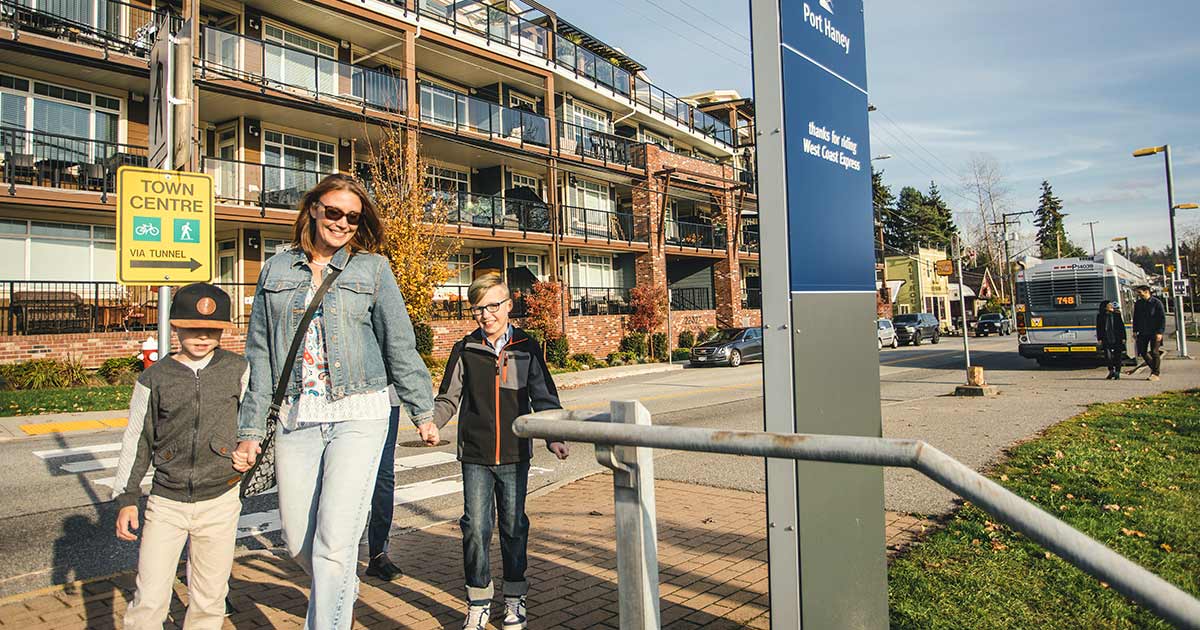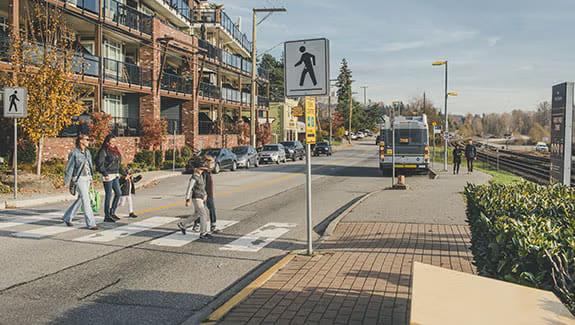TravelSmart for Kids Strategy

TravelSmart4Kids Newsletter
Stay up to date with the latest on children's sustainable travel initiatives, research, and resources from Metro Vancouver and beyond!
TravelSmart4Kids is a first of its kind strategy that seeks to create a region that is safe, healthy, and sustainable to ensure future generations know how to navigate a multi-modal transportation network. It is a regional, coordinated strategy to encourage more children between the ages of 0 to 12 to travel by active and sustainable modes of transportation in Metro Vancouver, including walking, cycling, rolling, and taking transit.
The Strategy includes a clear vision and goals for children’s travel in the region. The Strategy addresses some of the current barriers and challenges of active and sustainable travel for children are facing in our region. It also looks forward and aims to create changes in these three focus areas:
Culture and Behaviour: Create a culture for healthy and safe active and sustainable transportation.
Sustainability and Legacy: Support the sustainability and legacy of active and sustainable travel initiatives that focus on children.
Resources and Funding: Builds on the need for additional resources and funding to sustain programs, initiatives, and infrastructure that support sustainable travel for children.
The implementation of the Strategy involves all the organizations and agencies that helped to develop it. Every stakeholder has a role to play. A lot of stakeholders are already doing a lot of work that aligns with the Strategy.
TravelSmart4Kids Strategy
The TravelSmart4Kids Strategy and the Executive Summary are now available for download.
A Regional, Coordinated Approach
We're More Effective Together
In the past, funding and resources have been put to programs and initiatives that are intended to encourage active travel to school without fully understanding the impact they have.
The creation of TravelSmart4Kids was a regional, team effort led by TransLink, along with school districts, municipalities, health authorities, regional and provincial governments, and many others.
Doing this work at the regional level helped to streamline our efforts and build support and ownership of the Strategy. We have the organizations and agencies within the region and province that have the passion, knowledge, and capacity to continue to do this work.
Breaking Down the Strategy
The Strategy’s framework ensures there is a clear vision and goals for children’s active and sustainable travel in the region. The themes are supported by strategies and actions to work towards the vision and goals. The vision is supported by two goals, with the support of three themes, and six strategies. Each strategy has a series of actions identified, there are a total of 56 actions.
TravelSmart4Kids is intended to be implemented collaboratively over the short- (0 to 1 years), medium- (1 to 5 years) and long-term (5+ years), and to align with TransLink’s Regional Transportation Strategy Transport 2050.
Four priority actions were identified that would have the greatest impact in the short-term and lay the foundations for future years.
- A Regional Coordinator role was created to champion and lead this work.
- A Regional Working Group was established for regional stakeholders to come together to provide a platform to share knowledge and learn from one another.
- Consolidate resources and reference materials already developed that can help encourage more active and sustainable transportation.
- Establish a formal commitment for the implementation of the Strategy. We are currently working to formalize existing relationships and create new commitments to ensure the Strategy has a lasting impact.
- Read the TravelSmart4Kids Strategy
- Read the TravelSmart4Kids Executive Summary
Initiatives
TravelSmart4Kids is the umbrella strategy that includes several other programs and initiatives you may already be familiar with. Many of these stemmed from the process of developing the strategy.
TravelSmart4Kids
Walking School Bus Program
Get on Board!
Kids 12 & Under Ride for Free
Cycling Education
Resources
Regional Working Group
-
Walking School Bus Program: No engine required! Walking school bus programs transform the school commute into a mood-lifting, friend-building, body-moving experience. Instead of being driven to school in a car, kids walk with parents who act as walk leaders to ensure kids arrive safely to and from school. The Walking School Bus program supports healthy minds, physical activity, and strengthens the community ties of kids and parents. Learn more about the benefits of the walking school bus and how it works:
-
SCY is a not-for-profit organization based in Vancouver that serves children province-wide. They provide a series of other programs and projects that centre children and youth that can be found on SCY’s website.
-
A Walking School Bus is a group of students who travel to and from school each day along a designated route, stopping along the way to pick up more students. Walk Leaders, trained adult supervisors, walk with the group daily. The bus is powered not by an engine, but on foot by the students themselves as they walk to and from school.
- Get on Board! Kids 12 & Under Ride Free: Children 12 and under can ride TransLink services free of charge as part of the Ministry of Transportation and Infrastructure program.
- Cycling Education Programs: The Everyone Rides Grade 4/5 program delivered by HUB Cycling and the Ministry of Transportation and Infrastructure provides British Columbia elementary students with skills, confidence, and the opportunity to learn to ride their bikes to and from school.
-
HUB Cycling is a not-for-profit organization that advocates for removing barriers to cycling in Metro Vancouver. To find out more about their work, visit Hub Cycling's website
The Walking School Bus initiative, delivered by the Society for Children and Youth of BC (SCY), is supported and funded by TransLink and the Ministry of Transportation and Infrastructure.
Online Resource Centre for Children’s Mobility
Toolkits, Reports, and Guidance
-
Active School Travel
-
Community Planning and Design Guidance
-
Cycling
-
Transit
-
Play
Educational Resources
-
TransLink's Kids Ride Free resources
-
A colourful comic book style transit tips sheet that highlights the basics of a transit trip.
-
Transit bingo for real world transit adventuring and experiential learning.
-
Mad libs for bus and SkyTrain to help young riders discover the fun in taking transit.
-
'Spot the Difference' activities to help review and practice transit-riding etiquette.
-
Our virtual bus tour tool is a fun way to tour the inside and outside of a bus before you go!
-
-
Infographics and shareables
Videos
Past Newsletters
-
October 2025: Falling into Active Travel Routines
-
May 2025: Unlock your Active Travel Superpowers this Summer!
-
March 2025: Welcome to the TravelSmart4Kids Newsletter
Datasets and Research on Children’s Active Travel
Datasets and Dashboards
-
Child Development Monitoring System (British Columbia)
-
The Child Development Monitoring System is a collection of tools designed to gather data at critical transition times in childhood across B.C., created and operated by the Human Early Learning Partnership (HELP), including:
-
ParticipACTION 2024 Report Card (Canadian)
Transportation Equity Dashboard (Mobilizing Justice) (Canadian)
Active School Travel Fact Sheet (Ontario-created, Canadian scope)
Best Practices in School Data Collection in Canada (Canadian)
Academic Research and Studies
-
Active School Travel (AST) and Children’s Health
-
Walking School Buses as a Form of Active Transportation for Children
-
Aerobic Fitness and Mode of Travel to School in Schoolchildren
-
Active Transport to School May Reduce Psychosomatic Symptoms in School-Aged Children
-
Risky Play and Children’s Safety: Balancing Priorities for Optimal Child Development
-
An assessment of the benefits of the walking school bus in Christchurch, New Zealand
-
Encouraging active transport to school: Walking School Bus lessons from Ontario
-
Commuting to school: Are children who walk more physically active?
-
Way2Go! Social marketing for girls’ active transportation to school
-
The effect of walking on preadolescent children’s cognitive control
-
Children’s Independent Mobility and their Environment
-
Children’s Experiences of the Journey between Home and School
-
Children’s Access to Non-School Destinations by Active or Independent Travel
-
Walking the Walk: Can Child Friendly Cities Promote Children’s Independent Mobility?
-
Influence of Neighbourhood Built Environments on the Outdoor Free Play of Young Children
-
Impact of Traffic Park Use on Children’s Traffic Rule Awareness and Behavioral Intentions
-
Children’s active travel and independent mobility in four countries
-
Environmental correlates of children’s active transportation: A systematic literature review
-
Traffic danger’s potential impact on children’s accessibility
-
-
Public Transit
-
Air Quality


